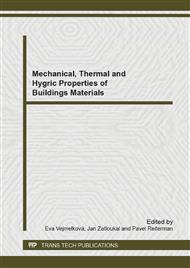[1]
Michal Drahorád, Marek Foglar, Pavel Veselý, Stanislav Smiřinský, The use of dynamic increase factor for speed-up of load tests of FRC specimens; Beton TKS 1/2012 - Pozemní stavby, pp.74-79.
Google Scholar
[2]
L. Javier Malvar, John E. Crawford; Dynamic increase factors for concrete; Twenty-Eighth DDESB Seminar, Orlando, FL, August (1998).
Google Scholar
[3]
Zielinski AJ., Reinhardt HW. Stress-strain behaviour of concrete and mortar at high rates of tensile loading. Cem Concr Res 1982: 12, pp.309-311.
DOI: 10.1016/0008-8846(82)90079-5
Google Scholar
[4]
Tuan Kiet, Dong Joo Kim; High strain rate effects on direct tensile behavior of high performance fiber reinforced cementitious composites; Cement & Concrete Composites 45 (2014), pp.186-200.
DOI: 10.1016/j.cemconcomp.2013.10.005
Google Scholar
[5]
Li QM, Meng H. About the dynamic strength enhancement of concrete-like materials in a split Hopkinson pressure bar test. Int J Solids Struct 2003; 40: 343-60.
DOI: 10.1016/s0020-7683(02)00526-7
Google Scholar
[6]
V.S. Gopalaratnam, S.P. Shah; Properties of steel fiber reinforced concrete subjected to impact loading; J Am Concr Inst, 83 (1) (1986), p.117–126.
Google Scholar
[7]
Bindiganavile V, Banthia N. Polymer and steel fiber-reinforced cementitious composites under impact loading. ACI Mater J 2001; 1998(1): p.10–16.
Google Scholar
[8]
Michal Matysík; Příprava a mechanizmus porušení struktury betonových trámců pro testování metodami nelineární akustické spektroskopie, Juniorstav 2009, sekce 4. 1.
Google Scholar
[9]
Pytlík, P. Technologie betonu. 2. vydání. VUT v Brně, Nakladatelství VUTIUM, 2000. ISBN.
Google Scholar
[10]
Fornusek, Jindrich; Konvalinka, Petr; Cairns, John J., Numerical Analysis of the Influence of Head Diameter on the Breakout Capacity of Shallow Headed Studs, Source: proceedings of the 50th annual conference on experimental stress analysis, Pages: 73-80 Published: (2012).
DOI: 10.1109/isbeia.2012.6422988
Google Scholar
[11]
Fornusek, J., Konvalinka, P., Numerical investigation of head diameter influence on tensile capacity of headed studs, Source: ISBELA 2012 - IEEE Symposium on Business, Engineering and Industrial Applications , art. no. 6422988 , pp.737-741.
DOI: 10.1109/isbeia.2012.6422988
Google Scholar
[12]
Sovják, R. - Vogel, F. - Beckmann, B., Triaxial Compressive Strength of Ultra High Performance Concrete, In: Acta Polytechnica. 2013, vol. 53, no. 6.
DOI: 10.14311/ap.2013.53.0901
Google Scholar
[13]
Maca, P.; Jandekova, D.; Konvalinka, P., The influence of metakaolin addition on the scaling of concrete due to frost action, CEMENT WAPNO BETON, Published: JAN-FEB (2014).
Google Scholar
[14]
Reiterman, P. - Kostelecká, M. - Kolář, K. - Konvalinka, P.: Application of Laser Microscope System for Evaluation of Separation Agents. In Measurement Technology and its Application. Uetikon-Zurich: Trans Tech Publications, 2013, pp.517-524.
DOI: 10.4028/www.scientific.net/amm.241-244.517
Google Scholar
[15]
T.K. Tran, D.J. Kim, Strain energy frame impact machine (SEFIM), J Adv Concr Technol, 10 (3) (2012), p.126–136, 80-214-1647-5.
DOI: 10.3151/jact.10.126
Google Scholar


